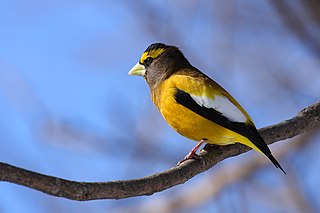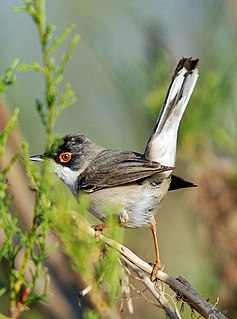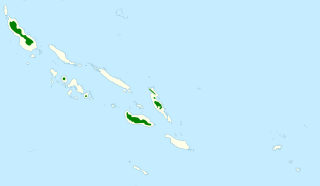
The American goldfinch is a small North American bird in the finch family. It is migratory, ranging from mid-Alberta to North Carolina during the breeding season, and from just south of the Canada–United States border to Mexico during the winter.

The fieldfare is a member of the thrush family Turdidae. It breeds in woodland and scrub in northern Europe and across the Palearctic. It is strongly migratory, with many northern birds moving south during the winter. It is a very rare breeder in Great Britain & Ireland, but winters in large numbers in the United Kingdom, Southern Europe, North Africa and the Middle East. It is omnivorous, eating a wide range of molluscs, insects and earthworms in the summer, and berries, grain and seeds in the winter.

The pink-footed goose is a goose which breeds in eastern Greenland, Iceland and Svalbard. It is migratory, wintering in northwest Europe, especially Ireland, Great Britain, the Netherlands, and western Denmark. The name is often abbreviated in colloquial usage to "pinkfoot". Anser is the Latin for "goose", and brachyrhynchus comes from the ancient Greek brachus "short" and rhunchos "bill".

The lesser grey shrike is a member of the shrike family Laniidae. It breeds in South and Central Europe and western Asia in the summer and migrates to winter quarters in southern Africa in the early autumn, returning in spring. It is a scarce vagrant to western Europe, including Great Britain, usually as a spring or autumn erratic.

The eastern marsh harrier is a bird of prey belonging to the marsh harrier group of harriers. It was previously considered to be conspecific with the western marsh harrier but is now usually classified as a separate species. It has two subspecies: C. s. spilonotus in eastern Asia and C. s. spilothorax in New Guinea.

The hawfinch is a passerine bird in the finch family Fringillidae. It is the only species placed in the genus Coccothraustes. Its closest living relatives are the Chinese grosbeak and Japanese grosbeak of East Asia, and the evening grosbeak and hooded grosbeak of North America.

The evening grosbeak is a passerine bird in the finch family Fringillidae found in North America.

The black francolin is a gamebird in the pheasant family Phasianidae of the order Galliformes, gallinaceous birds. It was formerly known as the black partridge. It is the state bird of Haryana state, India.

The masked shrike is a species of bird in the shrike family, Laniidae. It breeds in southeastern Europe and at the eastern end of the Mediterranean, with a separate population in eastern Iraq and western Iran. It is migratory, wintering mainly in northeast Africa. Although it is a short-range migrant, vagrants have occurred widely elsewhere, including northern and western Europe. It is the smallest member of its genus, long-tailed and with a hooked bill. The male has mainly black upperparts, with white on its crown, forehead and supercilium and large white patches on the shoulders and wings. The throat, neck sides and underparts are white, with orange flanks and breast. The female is a duller version of the male, with brownish black upperparts and a grey or buff tone to the shoulders and underparts. The juvenile has grey-brown upperparts with a paler forehead and barring from the head to rump, barred off-white underparts and brown wings аpart from the white primary patches. The species' calls are short and grating, but the song has melodic warbler-like components.

The chestnut munia or black-headed munia is a small passerine. It was formerly considered conspecific with the closely related tricoloured munia, but is now widely recognized as a separate species. This estrildid finch is a resident breeding bird in Bangladesh, Brunei, Cambodia, China, India, Indonesia, Laos, Malaysia, Burma, Nepal, the Philippines, Singapore, Taiwan, Thailand, Vietnam and Hawaii. It also has been introduced to all the Greater Antilles and Martinique in the Caribbean.

The pin-tailed sandgrouse is a medium large bird in the sandgrouse family. It has a small, pigeon like head and neck and a sturdy, compact body. It has long pointed wings, which are white underneath, a long tail and a fast direct flight. Flocks fly to watering holes at dawn. The call is a loud kattar-kattar. This gregarious species breeds on dry open treeless plains and similar habitats. Its nest is a ground scrape into which two or three cream-coloured eggs with cryptic markings are laid. Both sexes incubate the eggs.

The grey-headed lapwing is a lapwing species which breeds in northeast China and Japan. The mainland population winters in northern Southeast Asia from northeastern India to Cambodia. The Japanese population winters, at least partially, in southern Honshū.

The Daurian redstart is a small passerine bird from temperate Asia. In Japan, it is known as jōbitaki (ジョウビタキ). The species was first described by Peter Simon Pallas in 1776.

The bar-breasted firefinch is a common species of estrildid finch found in western and central Africa. It has an estimated global extent of occurrence of 2,900,000 km².

The chestnut-breasted mannikin, also known as the chestnut-breasted munia or bully bird, is a small brown-backed munia with a black face and greyish crown and nape. It has a broad ferruginous breast bar above a white belly. The species is found in Australia, New Caledonia, Indonesia, and Papua New Guinea. This species has also been introduced to French Polynesia and France.

Menetries's warbler or Ménétries's warbler is a small passerine bird of Southwest Asia belonging to the genus Curruca. The name of the species commemorates Édouard Ménétries, the French zoologist who described the species in 1832. It is closely related to the Sardinian warbler of the Mediterranean basin and is similar to it in appearance.

The pale mountain pigeon is a species of bird in the pigeon family Columbidae. It is endemic to the Solomon Islands archipelago, where it inhabits old-growth and secondary montane forest. It is a medium-size pigeon with an average length of 38 cm (15 in) and a weight of 310–385 g (10.9–13.6 oz). The head and neck are whitish-grey, the belly and lower breast are buffy-pink, and the vent and undertail coverts are pale grey. The upperparts are smoky-grey with darker fringes on the mantle and wing coverts. Both sexes look similar, but there can be large variation in individual appearance.

The pale thrush is a passerine bird of the eastern Palearctic belonging to the genus Turdus in the thrush family Turdidae. It is closely related to the eye-browed thrush and grey-backed thrush.

The Socotra golden-winged grosbeak or Socotra grosbeak is a finch endemic to Socotra, an island in the Indian Ocean off the coast of Yemen. R. socotranus is by some authorities held to be the only species of the then-monotypic genus Rhynchostruthus, including all other golden-winged grosbeaks therein as subspecies. But in recent times the three populations are usually considered a distinct species, with R. socotranus being limited to the Socotra population, the Arabian golden-winged grosbeak becoming R. percivali, and the Somali golden-winged grosbeak R. louisae.

The African crimson-winged finch is a pale-colored thickset finch with a heavy, dull yellowish bill. It is found in the Atlas Mountains of Morocco and Algeria. It was formerly considered a subspecies of the Asian crimson-winged finch. It has an average length of 13 cm (5.1 in) and a wingspan of ca. 32 cm (13 in). It is light brown overall, with a whitish mid-belly, a black cap and a pinkish pattern on the wings and tail. The female is slightly duller than the male.
























